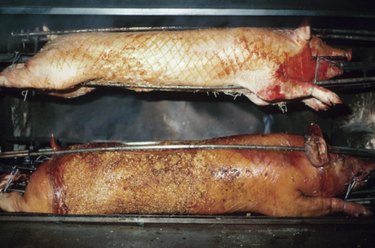Things You'll Need
Spit-roasted suckling pig, or mature hog
Sturdy table
Aluminum foil
3 cutting boards
Sharp carving knife
Carving fork
Disposable towels
Sterilized saw or pruning shears
Serving platters
Sauces and side dishes as desired.

Whole roasted pigs are a celebratory meal in many cultures around the world, including many parts of the United States. In the past this was often done in or over a pit full of hot coals, but today many entrepreneurial companies offer prefabricated pig-roasting carts that make the process relatively easy. For many backyard enthusiasts, the moment of truth comes at the end of the process, when the pig has been successfully cooked and they are faced with the necessity of carving more meat than they've ever seen in one place.
Setting Up
Step 1
Prepare a suitably large, sturdy surface for carving the pig. A picnic table covered with several layers of aluminum foil will serve the purpose.
Video of the Day
Step 2
Lift the pig by its spit, and move it to the waiting table. This will require at least two people, and perhaps as many as six, depending on the size of your pig.
Step 3
Remove the spit and any other wires, skewers or bindings from the pig. Bring three large cutting boards to the work area, along with a sharp knife, carving fork and a supply of disposable towels to wipe your work surface clean as you carve.
Step 4
Cut away the crisp skin, or crackling, from the pig. This can be served out immediately to those of your guests who like it, or kept warm beside the coals until the rest of the pig is carved.
Step 5
Allow the pig to rest for 20 to 30 minutes before carving. This provides time to finish making and setting out any sauces and side dishes.
Carving
Step 1
Start by cutting away a foreleg and shoulder. Hold the leg on one of your cutting boards and slice the meat across the grain. Rotate the leg as you carve to get the meat from all sides. Wipe your work area with disposable towels as often as necessary to keep it clean.
Step 2
Slice down along the backbone and then horizontally across the top of the ribs to free up a loin. Place this on your second cutting board, and slice it across the grain into neat, boneless portions.
Step 3
Cut away a hind leg, and position it on your third cutting board. You may need a second person to hold this for you, depending on the size of the pig. Again, slice the meat across the grain to create a mound of portions on your cutting board.
Step 4
Have your guests start seating themselves, then break the ribs from the backbone or cut them away with a sterilized saw, or pair of sterilized pruning shears. Separate the ribs and divide them between the three cutting boards. Do the same with the soft, fatty belly meat.
Step 5
Fill serving platters with pork from all three cutting boards, and either have them served out or place them where your guests can serve themselves. Send your sauces and side dishes to the tables along with the pork.
Step 6
Repeat the same process on the other side of the pig. Leftovers can be packaged and frozen for later use.
Tip
Larger animals are harder to spit-roast successfully. If you have a large crowd to feed, order two smaller pigs rather than one large one.
Video of the Day